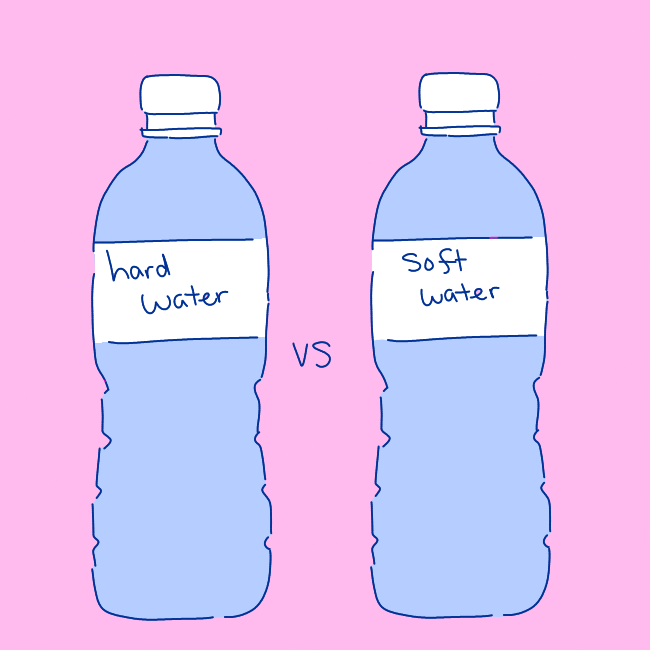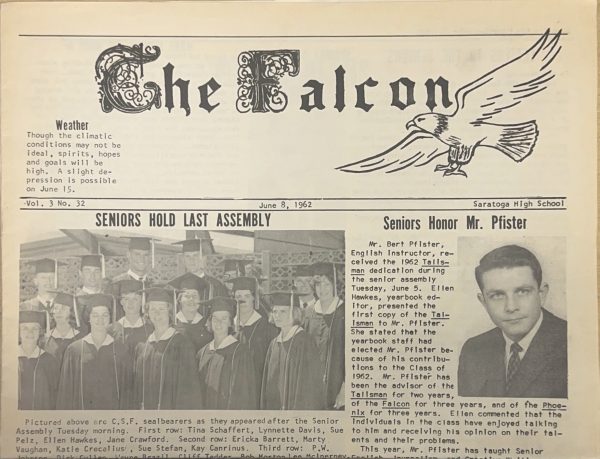Teeming with life, the journalism room of the 1960s — a portable classroom sitting near where the current Saratoga High Library stands — was the bustling epicenter of work each deadline night, when the publication was due to be sent off to the printer for proofs.
Students’ fingers fly across typewriters, diligently making final changes to their stories while editors monitor task completion, keeping the newspaper’s progress on track. Despite the ticking clock, an undeniable sense of camaraderie permeates through the room, with each member determined to deliver a polished newspaper for readers to enjoy.
Now, more than six decades later, the school’s new journalism room — affectionately called the “J-Room” by staffers — remains a hive of activity during those same deadline nights. However, immense changes have taken place since the Falcon’s founding in 1959 — more than half a century later, the program has adopted a new room, advanced technology, stylistic changes and new sections.
Technology advanced the Falcon to new heights
From The Falcon’s first issue in 1959 to the late 1990s, students designed newspaper pages by gluing cutouts to a large rectangle of cardboard.
Before former newspaper adviser Paul Page — who held the position from 1985 to 1991 — helped secure funds to buy the Falcon’s first Macintosh computer in 1988, reporters not only designed layouts manually, but also wrote stories using typewriters. At the end of deadline night, they sent out stories and designs on paper to an external facility like Folger Graphics, which printed and sent them back in a long, 2-inch wide roll.
Students then cut the roll into strips containing pieces of the layout — for instance, the headline or body text of a story — and then pasted each component onto a cardstock board with light-blue columns and rows, called a paste-up board.
Finally, these boards would be sent back to the printers, who made plates and printed the actual issue.
To add visual elements, students marked photograph frames to their desired size before taking them to a printer, which then created the photos by dotting ink onto the page.
Even after purchasing Macintoshes, this publishing system persisted for a few years, as students adjusted to the technological transition.
Under Kerry Mohnike, who served as newspaper and yearbook adviser from 1991 to 1996, the Falcon transitioned from physical newspaper-making to a more digital approach.
The program purchased more computers, and according to Mohnike, Falcon staff were forced to learn to work with the technology on the fly, navigating its various challenges during the school year. The staff in the early ‘90s used Adobe Pagemaker, and it wasn’t until 2000 that the staff started using Adobe InDesign to design layouts, arranging photos and text upon a page with the same tools they use today.
Current newspaper adviser Michael Tyler began teaching here in 1996 — during that era, students used Macintoshes to print elements, which were then cut and glued onto 11- by 17-inch pages. When all of these draft paper pages were completed, they were still delivered in a box to Folger Graphics, who handled the printing and copying process.
According to Tyler, the most significant technological advancement the program experienced was the adoption of digital photography. In the 90s, students had to develop all of their film. Often, they would take more than 50 shots of a sports game, but after developing rolls of film, they would find that none of the photos were good. Thus, students were often frustrated when they got shoe-boxes full of photos, when none of them even worked. Eventually, they came to the first digital cameras, which although were lower quality than the ones today, they made the process of selecting photos vastly more efficient.
According to Tyler, Folger Graphics and other printing companies took photos of the pages and etched them onto a large metal plate, which then went into the printing press. This primitive process meant that the quality of photos was still vastly more blurred compared to current digitally created layouts.
As newspapers across the nation transitioned away from print issues and focused more on online articles to suit the changes in their readership, The Falcon has been adapting as well. In 2001, The Falcon started posting content on the earliest version of its website. However, without modern website hosting or design tools like GoDaddy and WordPress, Tyler said the site relied too much on tech-savvy students. When they graduated, the site ran into tech issues and went down.
In 2008, The Falcon created a more modern website, a database-driven one which has lasted to this day. This year, the Falcon shifted its website provider from GoDaddy to SNO to incorporate even more multimedia components into online articles, such as videos of games in the Sports section.
The 2000s also saw students switching over to the Adobe suite, which includes programs such as Adobe InDesign, Illustrator and Photoshop. Now, students can also use the new set of iMacs added to the J-Room in 2022, allowing them to work with advanced software on large, 2-foot screens.
Initially, work was saved using 128-kilobyte floppy disks and hard drives; later, in around 2020, page and story storage transitioned to the Creative Cloud. Before this, student’s still used Adobe Suite, but their work was limited to only journalism desktops. Now, students can save and share their work on their own devices.
Today, The Falcon is in the process of transitioning toward a more digital journalism organization, also leaving behind traditional print issues in favor of five all-color magazines each year. But staffers will continue to use the Adobe suite — now in the cloud — to produce layouts and edit their photos.

The Falcon’s first template in 1959
The template for The Falcon’s first issue in 1959 serves as a blueprint for where text and photographs should be placed. Written on the top of the page are guidelines for the width of columns and the word “pica,” which corresponds to 1/6 of an inch and is used to measure spacing on a page.

Sept. 14, 1959 — Vol. 1, No. 1: The Falcon launches the first issue with hand-drawn features
Pictured here is the front page of the Falcon’s first issue, published September of 1959, with hand-drawn headlines and logos. The issue was printed on light turquoise-blue paper and text was typed on a typewriter. At the time, no modern technology, such as computers, were utilized for the issue. The original issue consisted of four 11 by 14-inch pages, folded horizontally to produce an 8-page issue. The newspaper sections included only News, Sports, Features and Opinion.

June 8, 1962 — Vol. 3, No. 32: Newspaper switches to large “standard” style paper
The publication of the 32nd issue of the third year (Volume 3, number 32) marked the first large step towards the transformation to most modern Falcon newspapers. Compared to prior issues, this newspaper did not use 11- by 14-inch light turquoise paper, adopting instead large 11- by 17-inch off-white colored paper. This issue maintained the hand-drawn logo at the top of the front page, but added multiple black and white photos as well as the date, volume and issue number in numeral form.

April 5, 1996 — Vol. 35, No. 10: Through usage of technology, the Falcon develops color and structure
The seventh issue of Volume 36, released on Dec. 19, 1996, displays the first printed color in the Falcon newspaper. As pictured, the front page includes solid turquoise in select areas. Due to additional expense, color was limited to a single color and small areas.
This issue marks the beginning of the transition of a physically-made newspaper to a digitally-made newspaper and was the first to be split into five sections, with the addition of Entertainment. However, the previous hand-drawn logo from the older issues pictured was discarded in the Falcon’s transition to new, digital design softwares. In addition, this issue featured a structured format with headlines, decks, bylines, captions, pull-quotes and barrier lines between stories.

Nov. 17, 2000 — Vol. 41, No. 4: Progression in the use of color brings the newspaper to life
This 20-page issue holds the first full-colored backpage featuring a peach background, multi-colored accents and a larger number of colored photos.
The fourth issue of Volume 41, released on Nov. 17, 2000, displays an increase in color variety and amount on the front page. This issue boasts much more color than previous ones: The front page includes the name of the newspaper in red, section titles in navy blue, multi-colored graphics and the very first colored photographs. The back page — the last page of the newspaper — also featured colored photos and pops of colors.
The Life section’s double-page also contained some color, with sparse, vibrant photos, headlines and small graphics.
The masthead also inched towards the present-day logo as it included the word “The” in comparison to previous name plates which only included “Saratoga Falcon.”

Sept. 16, 2011 — Vol. 52, No. 1: Color breakthroughs bring the Falcon closer to modern editions
The Sept. 16, 2011 issue is the earliest issue that resembles modern newspapers, with its first, fully-colored double-page.
The backpage’s format is nearly identical to the latest newspaper print issues, featuring a top ten ranking and crossword puzzle. The font and headline style also mimic the modern print version. In comparison to the issue in 2000, color is not used as generously, complementing the simplistic style of the issue.

Oct. 4, 2024 — Vol. 65 No. 1: Falcon pivots to an all-color magazine, and continues establishing its online presence.
Pictured here is the very first magazine published by the Falcon, released in October 2024. This 34-page issue is the first to be completely filled with color; previous editions only had color on the front-page, backpage, Lifestyles section’s double-page and a select few others.
“Going forward, the Falcon is likely to continue adapting to its shifts in readership style. In the future, I suspect the publication is likely to fully move away from the print issue as well,” Tyler said.




































